This post is part of the “Autumn Hiking Across Korea 2025” series — your guide to Korea’s most inspiring fall trails.
🏞️ Seoul Autumn Hiking Gwanaksan (Mt. Gwanak)
Urban peaks + temple trails + golden maples
Suggested Route (Lucia’s favorite)
🚶 Seoul National University Station (Line 2) → Gwanak Mountain Park (관악산공원)→ Gwaneumsa Temple → Yeonjudae Hermitage→ Gwanaksan Peak (629 m)
→ Gwanaksan Ridge Trail (37.4407, 126.9769)→ Seoul Grand Park Station (Line 4) ✅
⏱ Time: 3.5 – 4.5 hours (one-way)
🥾 Trail Type: Steep rocky ascent, forest ridge, lakeside descent
🌿 Seoul Autumn Hiking Gwanaksan Course – Stops Along the Trail
1️⃣ Gwanak Mountain Park (관악산공원)
The main trailhead behind Seoul National University.
A gentle forest path lined with pines and small shrines — the calm before the climb.
2️⃣ Gwaneumsa Temple (관음사)
A serene Buddhist temple built into the mountain’s slope.
Its courtyard bursts into gold and crimson each fall,
and the sound of monks’ chanting echoes softly through the trees.
3️⃣ Yeonjudae Hermitage (연주대)
A cliffside sanctuary dramatically perched on granite rock.
The panoramic view from here — Seoul sprawling beneath autumn clouds —
is one of the most breathtaking sights in the city.
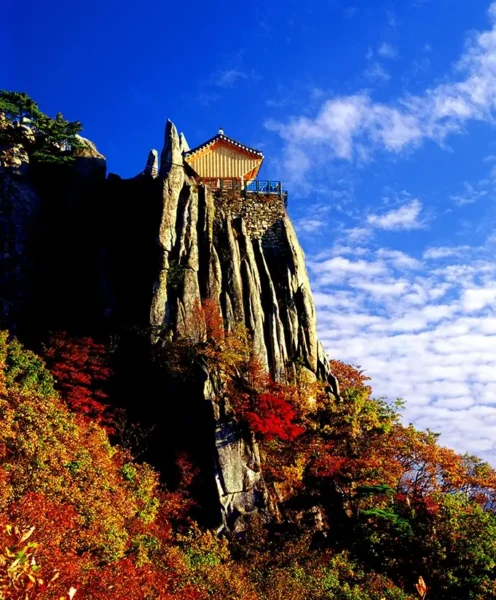
4️⃣ Gwanaksan Peak (629 m)
The summit marks the highest point of the trail,
where weathered rock meets sky and hikers rest above a sea of color.
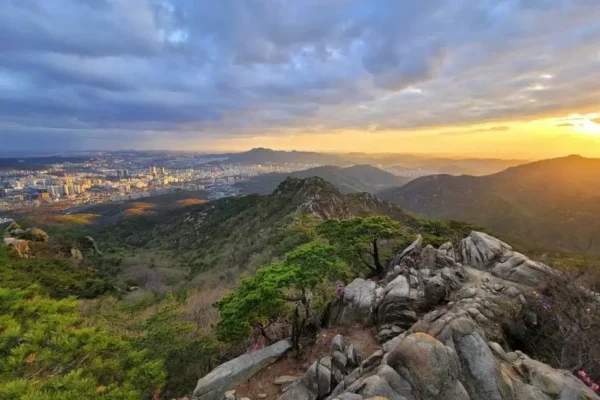
5️⃣ Gwanaksan Ridge Trail (37.4407, 126.9769)
Follow the scenic ridge toward Gwacheon.
The narrow stone path winds through red maples and golden oak —
a quieter section where the forest hums in autumn breeze.
6️⃣ Seoul Grand Park Station (Line 4)
The trail ends near a tranquil pond beside the reservoir.
Locals call this “Gwanaksan Lake Park,”
a hidden spot where maple reflections shimmer on still water.
Highlights
Ascent: Forested temple path leading to Gwaneumsa and Yeonjudae — a mix of calm, cliffs, and crimson leaves.
Summit: The granite crown of Seoul, offering a 360° view framed by mountain ridges and city skyline.
Ridge Trail: A quiet mid-descent through open rock and maple forest, perfect for late-afternoon light.
Descent: Gentle forest slope leading to Seoul Grand Park, ending by the lakeside pavilion mirrored in autumn gold.
End Point: Short walk to Seoul Grand Park Station (Line 4), with easy subway access back downtown.
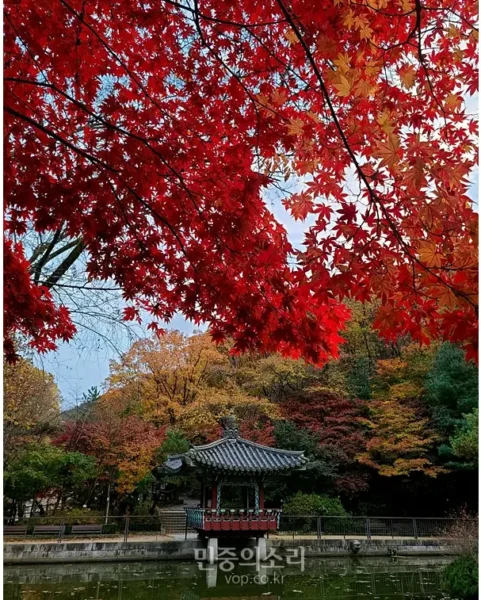
How to Get There
Start:
🚇 Subway Line 2 → Seoul Nat’l Univ. Station (Exit 3) → walk 15 min to the university’s back gate.
🚌 Bus 5511 or 5513 from downtown → get off at “Seoul National University Back Gate.”
Return:
🚇 From Seoul Grand Park Station (Line 4) → transfer at Sadang to Line 2 back to city center.
Local Food to Try 🍲
After descending to Gwacheon, stop at Seoul Grand Park Traditional Market for:
Pajeon (파전, crispy green-onion pancake) + makgeolli (막걸리, rice wine) — the classic Korean mountain combo.
Sundubu jjigae (순두부 찌개, spicy soft tofu stew) in local diners near the station.
🍵 Lucia’s Tip: After hiking, locals often share a warm pot of makgeolli and pajeon under the market tents — it’s part of the mountain ritual.
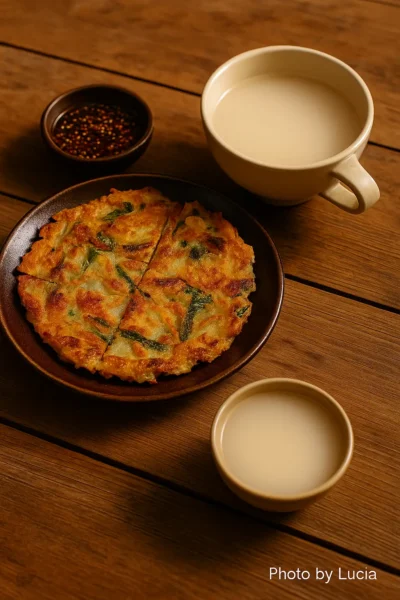
Official Info
🏯 Seoul Autumn Hiking Namhansanseong Fortress Trail (verified 2024)
Stone walls, crimson maples, and Korean heritage in autumn light
Suggested Route (Lucia’s Scenic & Historic Loop)
Sanseong Rotary (산성로터리) → North Gate (북문) → West Gate (서문) → Sueojangdae Command Post (수어장대) → South Gate (남문) → Return to Sanseong Rotary
Time: 2 hours (loop)
Distance: 5 km
Trail Type: Fortress wall trail, forest path, gentle slopes, panoramic ridges
🌿 Stops Along the Trail
1️⃣ Sanseong Rotary (산성로터리)
Start your walk from the heart of Namhansanseong Village, where fortress walls rise through a canopy of crimson and gold.
The air here carries the scent of pine and history — a perfect beginning to your fortress walk.
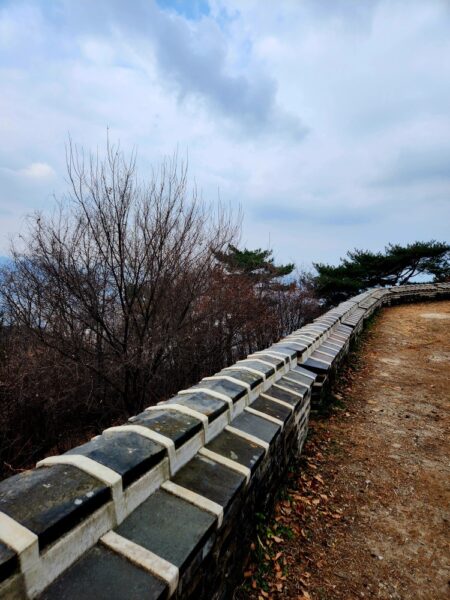
2️⃣ North Gate (북문)
Quiet and shaded, this section winds through a dense pine forest.
Listen to the rustle of leaves as you pass through the ancient arch of the gate, one of the best-preserved parts of the wall.
3️⃣ West Gate (서문)
A gentle ridge walk lined with tall pines and vibrant maples.
From here, glimpses of Seoul appear between fortress stones — a reminder of how close the city and nature truly are.
4️⃣ Sueojangdae Command Post (수어장대)
The symbolic heart of Namhansanseong Fortress.
Climb up to the pavilion for a breathtaking 360° panorama — the Seoul skyline, Gwanaksan, Bukhansan, and endless autumn peaks surround you.
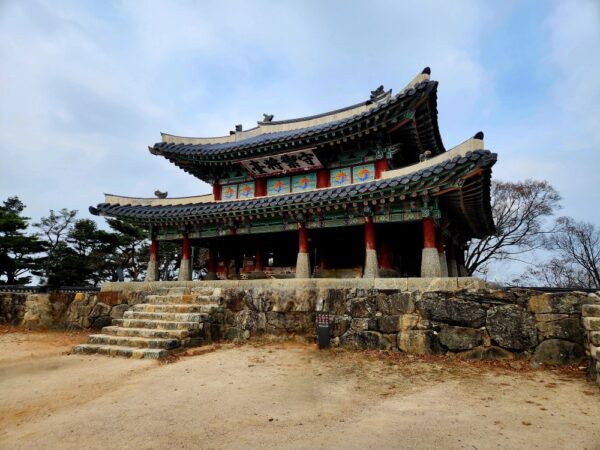
5️⃣ South Gate (남문 / Jihwamun)
The most visited of the four main gates.
Its wide stone steps and tiled roof create the perfect frame for fall foliage photos.
From here, descend slowly back toward Sanseong Rotary through golden forests.
6️⃣ Sanseong Village (남한산성 마을)
Finish your loop with a warm meal at one of the fortress village restaurants.
Traditional dishes like Hyojonggaeng (효종갱), tofu stew (두부전골), and acorn muk salad (도토리묵) capture the comforting taste of Korea’s mountain cuisine.
🍁 Highlights
Heritage Trail: UNESCO World Heritage fortress built in the 17th century under King Injo — a symbol of resilience and history.
Autumn Views: Vibrant red and gold leaves cascading over stone walls, best from West Gate to Sueojangdae.
Panoramic Point: Sueojangdae Pavilion offers one of the best skyline views of Seoul and surrounding peaks.
Local Flavor: Sanseong Village restaurants serve traditional Korean comfort food — the perfect end to your autumn loop.
🚉 How to Get There
Start: Subway Line 8 → Sanseong Station (Exit 2) → Take Bus 9 → Get off at Sanseong Rotary (산성로터리)
Return: Walk 5 minutes to Sanseong Rotary Bus Stop → Bus 9 → Sanseong Station
✨ Lucia’s Tip
Namhansanseong is more than a fortress — it’s a living museum of Korea’s history wrapped in autumn leaves.
Start early, walk slow, and enjoy the sound of your footsteps echoing through 1,000 years of stone and color.
🍲 Local Food to Try
Hyojonggaeng (효종갱) — A rich, slow-simmered beef and seafood soup once served to noble families in the Joseon era.
Born in the mountain villages around Namhansanseong, this dish was carried overnight to Seoul’s scholars at dawn — Korea’s first “delivery food.”
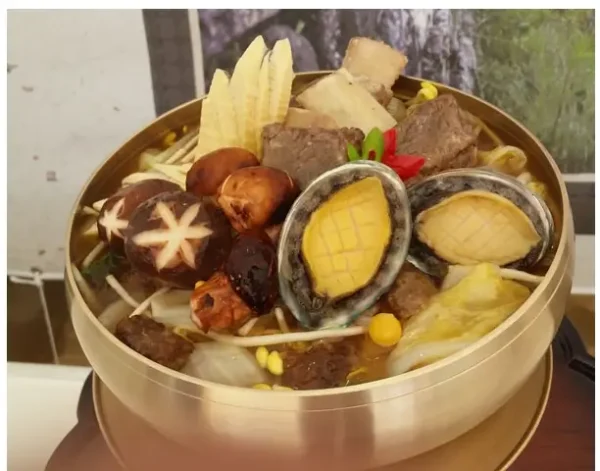
Tofu Stew (두부전골) — A hearty hotpot with fresh tofu, vegetables, and mushrooms, perfect after a cool autumn hike.
Often shared with a bowl of rice and makgeolli for a cozy mountain meal.
Acorn Muk Salad (도토리묵무침) — A light, nutty jelly salad mixed with sesame oil and spicy vegetables, offering a refreshing balance to rich stews.
Lucia’s Tip: Try these local dishes at Sanseong Village restaurants near the South Gate — the warm flavors and rustic atmosphere make the perfect ending to your fortress walk. 🍁
📌 Official Info
🌸 Lucia’s Note
“Each of these Seoul trails tells a different story — of temples, rivers, and fortress walls — but all end the same way: with warm food, quiet air, and the gentle sound of autumn leaves.”
🥾 This article is part of the Autumn Hiking Across Korea 2025 series.
👉 Continue your journey with Part 1: Bukhansan & Achasan – Seoul Autumn Hiking 2025
and explore Seoul’s breathtaking northern mountain trails. 🌿
🍁 Next in the Autumn Hiking Series: Coming soon
Pingback: Seoraksan Hiking Guide 2025 | Discover Korea’s Most Beautiful Autumn Trails